Report on Human Resource Management Practices at Tesco
VerifiedAdded on 2020/07/23
|16
|4467
|78
Report
AI Summary
This report provides a comprehensive overview of Human Resource Management (HRM) practices at Tesco, a leading UK multinational grocery and retailer. It begins with an introduction to HRM, emphasizing its role in maximizing employee performance and organizational efficiency. The report then delves into specific aspects of HRM, including the purpose and functions of HRM, the strengths and weaknesses of internal and external recruitment and selection approaches, and the benefits of various HRM practices for both the employer and employees. Furthermore, it assesses the effectiveness of HRM practices in raising organizational productivity and profit. The report highlights Tesco's approach to workforce planning, employee relations, and the impact of employment legislation on decision-making. Through detailed analysis, the report illustrates how Tesco leverages HRM to achieve its strategic objectives, foster a positive work environment, and drive organizational success. The report includes sections on workforce planning, employee relations, and the influence of employment legislation on decision-making within the context of Tesco's operations.
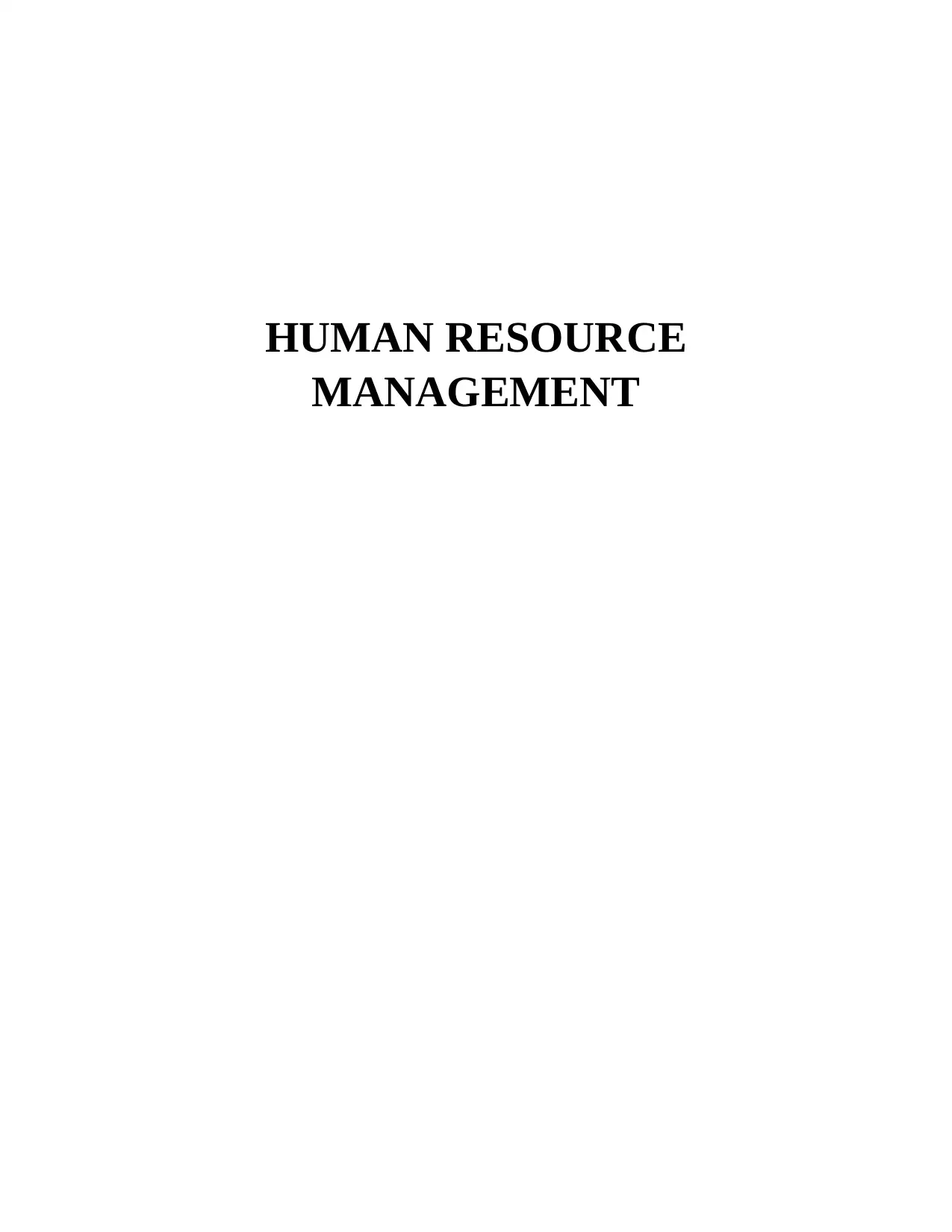
HUMAN RESOURCE
MANAGEMENT
MANAGEMENT
Paraphrase This Document
Need a fresh take? Get an instant paraphrase of this document with our AI Paraphraser

Contents
INTRODUCTION.....................................................................................................................................3
TASK 1...................................................................................................................................................3
P1 Purpose and Function of Human Resource Management...................................................................3
P2 Strength and weakness of different approaches to recruitment and selection.....................................4
P3. Benefits of HRM practices................................................................................................................7
P4 Effectiveness of different HRM practices in terms of raising organizational productivity and profit. 7
TASK 2...................................................................................................................................................8
P5 Significance of good employee relation.............................................................................................8
P6 Key components of employment legislations & its influence on decision making.............................9
P7 Application of HRM practices..........................................................................................................10
CONCLUSION....................................................................................................................................14
REFERENCES..........................................................................................................................................15
INTRODUCTION.....................................................................................................................................3
TASK 1...................................................................................................................................................3
P1 Purpose and Function of Human Resource Management...................................................................3
P2 Strength and weakness of different approaches to recruitment and selection.....................................4
P3. Benefits of HRM practices................................................................................................................7
P4 Effectiveness of different HRM practices in terms of raising organizational productivity and profit. 7
TASK 2...................................................................................................................................................8
P5 Significance of good employee relation.............................................................................................8
P6 Key components of employment legislations & its influence on decision making.............................9
P7 Application of HRM practices..........................................................................................................10
CONCLUSION....................................................................................................................................14
REFERENCES..........................................................................................................................................15
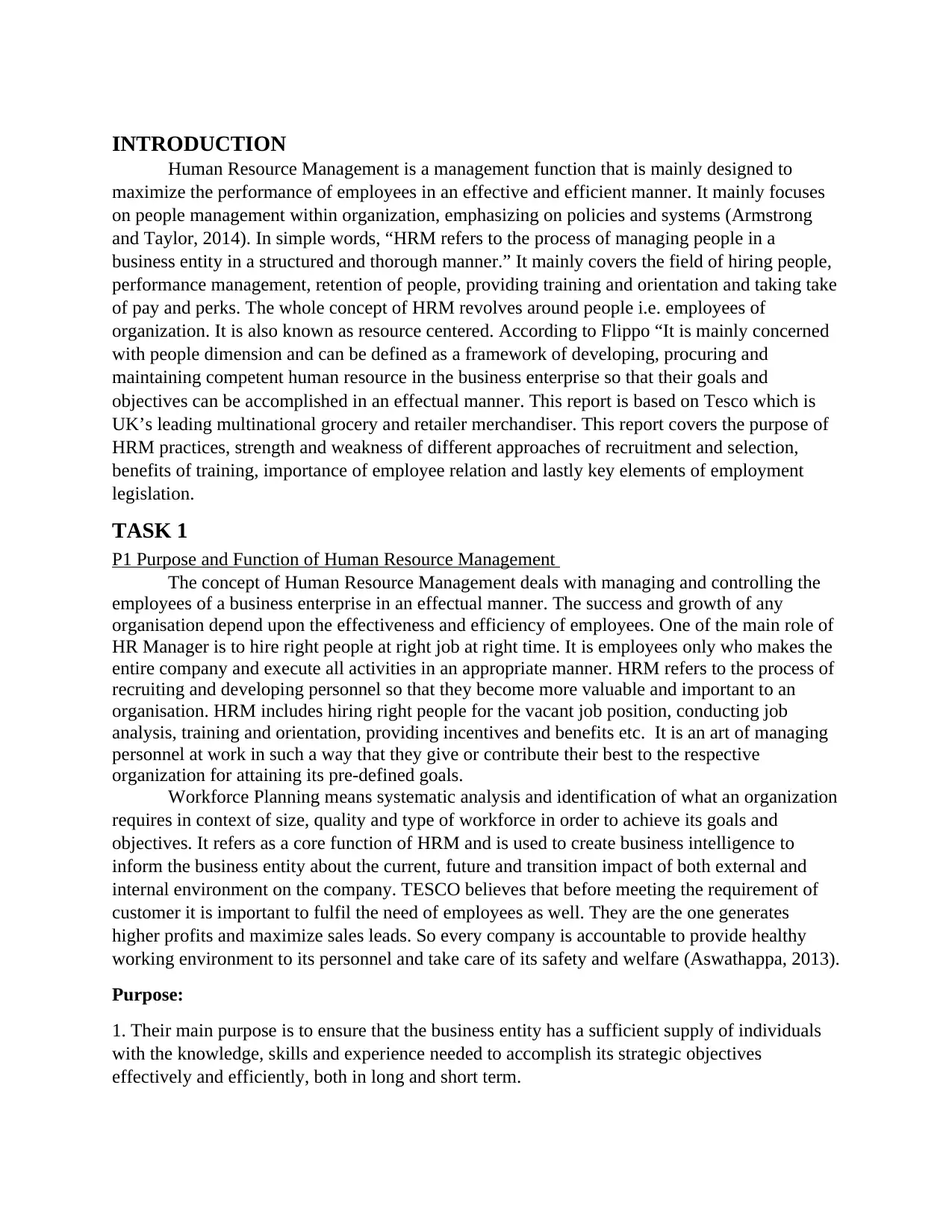
INTRODUCTION
Human Resource Management is a management function that is mainly designed to
maximize the performance of employees in an effective and efficient manner. It mainly focuses
on people management within organization, emphasizing on policies and systems (Armstrong
and Taylor, 2014). In simple words, “HRM refers to the process of managing people in a
business entity in a structured and thorough manner.” It mainly covers the field of hiring people,
performance management, retention of people, providing training and orientation and taking take
of pay and perks. The whole concept of HRM revolves around people i.e. employees of
organization. It is also known as resource centered. According to Flippo “It is mainly concerned
with people dimension and can be defined as a framework of developing, procuring and
maintaining competent human resource in the business enterprise so that their goals and
objectives can be accomplished in an effectual manner. This report is based on Tesco which is
UK’s leading multinational grocery and retailer merchandiser. This report covers the purpose of
HRM practices, strength and weakness of different approaches of recruitment and selection,
benefits of training, importance of employee relation and lastly key elements of employment
legislation.
TASK 1
P1 Purpose and Function of Human Resource Management
The concept of Human Resource Management deals with managing and controlling the
employees of a business enterprise in an effectual manner. The success and growth of any
organisation depend upon the effectiveness and efficiency of employees. One of the main role of
HR Manager is to hire right people at right job at right time. It is employees only who makes the
entire company and execute all activities in an appropriate manner. HRM refers to the process of
recruiting and developing personnel so that they become more valuable and important to an
organisation. HRM includes hiring right people for the vacant job position, conducting job
analysis, training and orientation, providing incentives and benefits etc. It is an art of managing
personnel at work in such a way that they give or contribute their best to the respective
organization for attaining its pre-defined goals.
Workforce Planning means systematic analysis and identification of what an organization
requires in context of size, quality and type of workforce in order to achieve its goals and
objectives. It refers as a core function of HRM and is used to create business intelligence to
inform the business entity about the current, future and transition impact of both external and
internal environment on the company. TESCO believes that before meeting the requirement of
customer it is important to fulfil the need of employees as well. They are the one generates
higher profits and maximize sales leads. So every company is accountable to provide healthy
working environment to its personnel and take care of its safety and welfare (Aswathappa, 2013).
Purpose:
1. Their main purpose is to ensure that the business entity has a sufficient supply of individuals
with the knowledge, skills and experience needed to accomplish its strategic objectives
effectively and efficiently, both in long and short term.
Human Resource Management is a management function that is mainly designed to
maximize the performance of employees in an effective and efficient manner. It mainly focuses
on people management within organization, emphasizing on policies and systems (Armstrong
and Taylor, 2014). In simple words, “HRM refers to the process of managing people in a
business entity in a structured and thorough manner.” It mainly covers the field of hiring people,
performance management, retention of people, providing training and orientation and taking take
of pay and perks. The whole concept of HRM revolves around people i.e. employees of
organization. It is also known as resource centered. According to Flippo “It is mainly concerned
with people dimension and can be defined as a framework of developing, procuring and
maintaining competent human resource in the business enterprise so that their goals and
objectives can be accomplished in an effectual manner. This report is based on Tesco which is
UK’s leading multinational grocery and retailer merchandiser. This report covers the purpose of
HRM practices, strength and weakness of different approaches of recruitment and selection,
benefits of training, importance of employee relation and lastly key elements of employment
legislation.
TASK 1
P1 Purpose and Function of Human Resource Management
The concept of Human Resource Management deals with managing and controlling the
employees of a business enterprise in an effectual manner. The success and growth of any
organisation depend upon the effectiveness and efficiency of employees. One of the main role of
HR Manager is to hire right people at right job at right time. It is employees only who makes the
entire company and execute all activities in an appropriate manner. HRM refers to the process of
recruiting and developing personnel so that they become more valuable and important to an
organisation. HRM includes hiring right people for the vacant job position, conducting job
analysis, training and orientation, providing incentives and benefits etc. It is an art of managing
personnel at work in such a way that they give or contribute their best to the respective
organization for attaining its pre-defined goals.
Workforce Planning means systematic analysis and identification of what an organization
requires in context of size, quality and type of workforce in order to achieve its goals and
objectives. It refers as a core function of HRM and is used to create business intelligence to
inform the business entity about the current, future and transition impact of both external and
internal environment on the company. TESCO believes that before meeting the requirement of
customer it is important to fulfil the need of employees as well. They are the one generates
higher profits and maximize sales leads. So every company is accountable to provide healthy
working environment to its personnel and take care of its safety and welfare (Aswathappa, 2013).
Purpose:
1. Their main purpose is to ensure that the business entity has a sufficient supply of individuals
with the knowledge, skills and experience needed to accomplish its strategic objectives
effectively and efficiently, both in long and short term.
⊘ This is a preview!⊘
Do you want full access?
Subscribe today to unlock all pages.

Trusted by 1+ million students worldwide
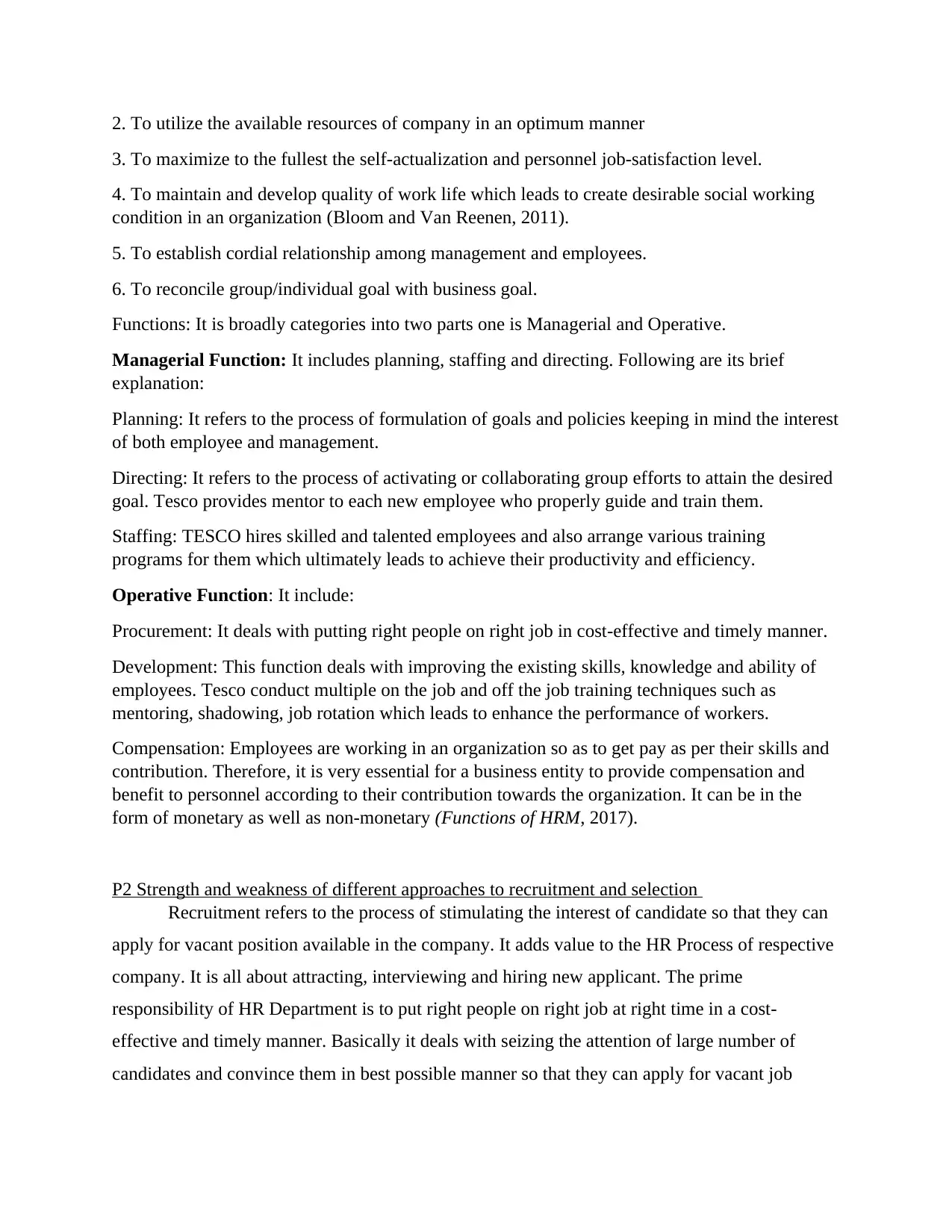
2. To utilize the available resources of company in an optimum manner
3. To maximize to the fullest the self-actualization and personnel job-satisfaction level.
4. To maintain and develop quality of work life which leads to create desirable social working
condition in an organization (Bloom and Van Reenen, 2011).
5. To establish cordial relationship among management and employees.
6. To reconcile group/individual goal with business goal.
Functions: It is broadly categories into two parts one is Managerial and Operative.
Managerial Function: It includes planning, staffing and directing. Following are its brief
explanation:
Planning: It refers to the process of formulation of goals and policies keeping in mind the interest
of both employee and management.
Directing: It refers to the process of activating or collaborating group efforts to attain the desired
goal. Tesco provides mentor to each new employee who properly guide and train them.
Staffing: TESCO hires skilled and talented employees and also arrange various training
programs for them which ultimately leads to achieve their productivity and efficiency.
Operative Function: It include:
Procurement: It deals with putting right people on right job in cost-effective and timely manner.
Development: This function deals with improving the existing skills, knowledge and ability of
employees. Tesco conduct multiple on the job and off the job training techniques such as
mentoring, shadowing, job rotation which leads to enhance the performance of workers.
Compensation: Employees are working in an organization so as to get pay as per their skills and
contribution. Therefore, it is very essential for a business entity to provide compensation and
benefit to personnel according to their contribution towards the organization. It can be in the
form of monetary as well as non-monetary (Functions of HRM, 2017).
P2 Strength and weakness of different approaches to recruitment and selection
Recruitment refers to the process of stimulating the interest of candidate so that they can
apply for vacant position available in the company. It adds value to the HR Process of respective
company. It is all about attracting, interviewing and hiring new applicant. The prime
responsibility of HR Department is to put right people on right job at right time in a cost-
effective and timely manner. Basically it deals with seizing the attention of large number of
candidates and convince them in best possible manner so that they can apply for vacant job
3. To maximize to the fullest the self-actualization and personnel job-satisfaction level.
4. To maintain and develop quality of work life which leads to create desirable social working
condition in an organization (Bloom and Van Reenen, 2011).
5. To establish cordial relationship among management and employees.
6. To reconcile group/individual goal with business goal.
Functions: It is broadly categories into two parts one is Managerial and Operative.
Managerial Function: It includes planning, staffing and directing. Following are its brief
explanation:
Planning: It refers to the process of formulation of goals and policies keeping in mind the interest
of both employee and management.
Directing: It refers to the process of activating or collaborating group efforts to attain the desired
goal. Tesco provides mentor to each new employee who properly guide and train them.
Staffing: TESCO hires skilled and talented employees and also arrange various training
programs for them which ultimately leads to achieve their productivity and efficiency.
Operative Function: It include:
Procurement: It deals with putting right people on right job in cost-effective and timely manner.
Development: This function deals with improving the existing skills, knowledge and ability of
employees. Tesco conduct multiple on the job and off the job training techniques such as
mentoring, shadowing, job rotation which leads to enhance the performance of workers.
Compensation: Employees are working in an organization so as to get pay as per their skills and
contribution. Therefore, it is very essential for a business entity to provide compensation and
benefit to personnel according to their contribution towards the organization. It can be in the
form of monetary as well as non-monetary (Functions of HRM, 2017).
P2 Strength and weakness of different approaches to recruitment and selection
Recruitment refers to the process of stimulating the interest of candidate so that they can
apply for vacant position available in the company. It adds value to the HR Process of respective
company. It is all about attracting, interviewing and hiring new applicant. The prime
responsibility of HR Department is to put right people on right job at right time in a cost-
effective and timely manner. Basically it deals with seizing the attention of large number of
candidates and convince them in best possible manner so that they can apply for vacant job
Paraphrase This Document
Need a fresh take? Get an instant paraphrase of this document with our AI Paraphraser
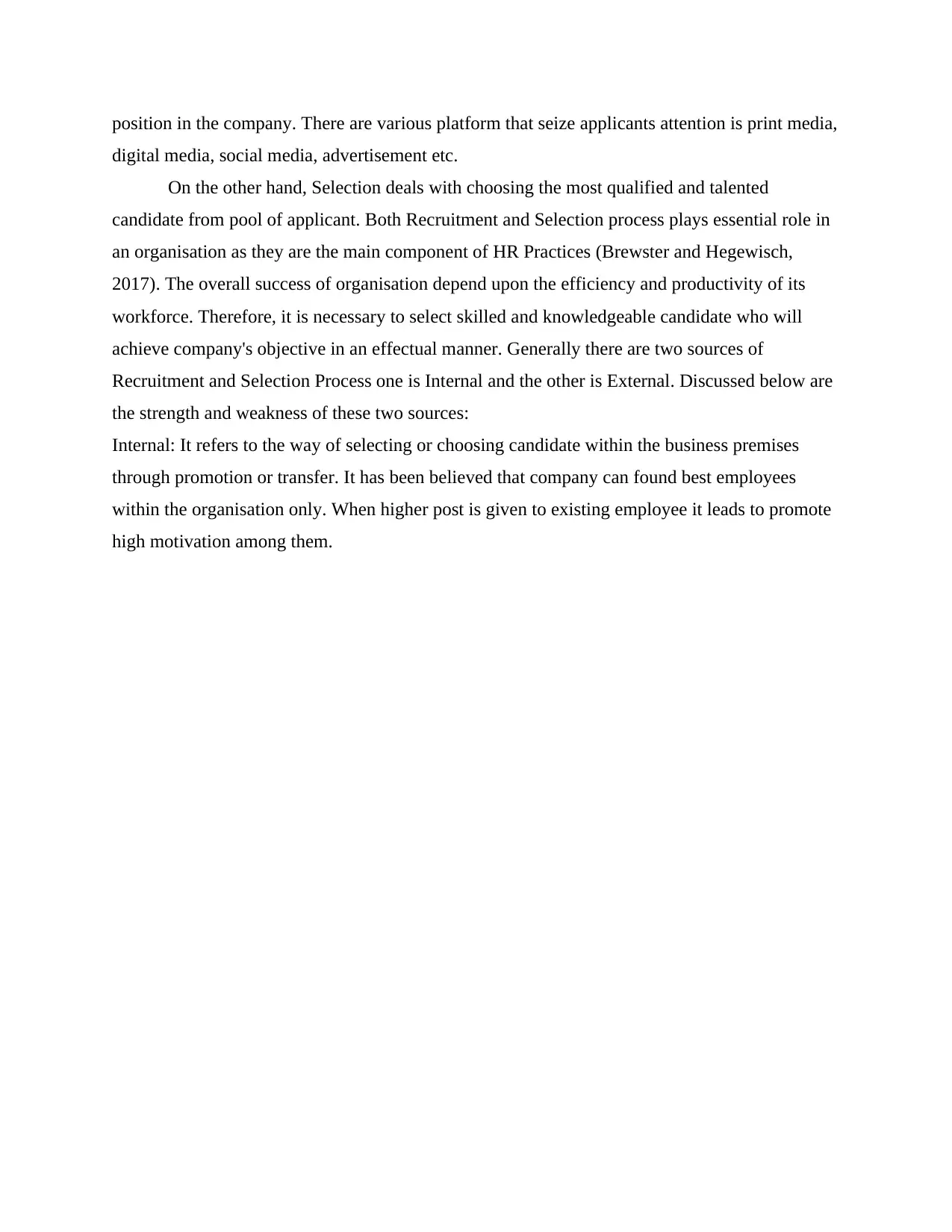
position in the company. There are various platform that seize applicants attention is print media,
digital media, social media, advertisement etc.
On the other hand, Selection deals with choosing the most qualified and talented
candidate from pool of applicant. Both Recruitment and Selection process plays essential role in
an organisation as they are the main component of HR Practices (Brewster and Hegewisch,
2017). The overall success of organisation depend upon the efficiency and productivity of its
workforce. Therefore, it is necessary to select skilled and knowledgeable candidate who will
achieve company's objective in an effectual manner. Generally there are two sources of
Recruitment and Selection Process one is Internal and the other is External. Discussed below are
the strength and weakness of these two sources:
Internal: It refers to the way of selecting or choosing candidate within the business premises
through promotion or transfer. It has been believed that company can found best employees
within the organisation only. When higher post is given to existing employee it leads to promote
high motivation among them.
digital media, social media, advertisement etc.
On the other hand, Selection deals with choosing the most qualified and talented
candidate from pool of applicant. Both Recruitment and Selection process plays essential role in
an organisation as they are the main component of HR Practices (Brewster and Hegewisch,
2017). The overall success of organisation depend upon the efficiency and productivity of its
workforce. Therefore, it is necessary to select skilled and knowledgeable candidate who will
achieve company's objective in an effectual manner. Generally there are two sources of
Recruitment and Selection Process one is Internal and the other is External. Discussed below are
the strength and weakness of these two sources:
Internal: It refers to the way of selecting or choosing candidate within the business premises
through promotion or transfer. It has been believed that company can found best employees
within the organisation only. When higher post is given to existing employee it leads to promote
high motivation among them.
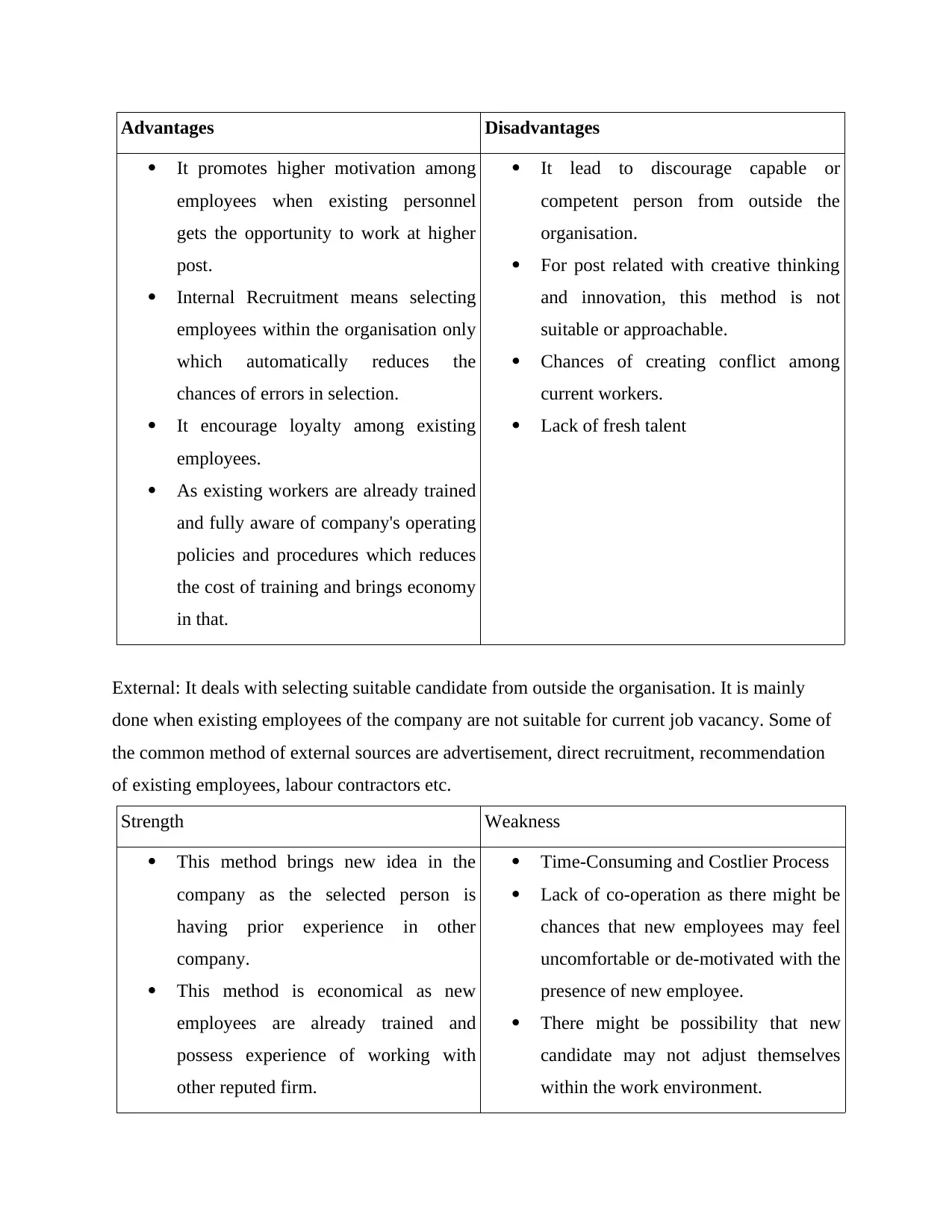
Advantages Disadvantages
It promotes higher motivation among
employees when existing personnel
gets the opportunity to work at higher
post.
Internal Recruitment means selecting
employees within the organisation only
which automatically reduces the
chances of errors in selection.
It encourage loyalty among existing
employees.
As existing workers are already trained
and fully aware of company's operating
policies and procedures which reduces
the cost of training and brings economy
in that.
It lead to discourage capable or
competent person from outside the
organisation.
For post related with creative thinking
and innovation, this method is not
suitable or approachable.
Chances of creating conflict among
current workers.
Lack of fresh talent
External: It deals with selecting suitable candidate from outside the organisation. It is mainly
done when existing employees of the company are not suitable for current job vacancy. Some of
the common method of external sources are advertisement, direct recruitment, recommendation
of existing employees, labour contractors etc.
Strength Weakness
This method brings new idea in the
company as the selected person is
having prior experience in other
company.
This method is economical as new
employees are already trained and
possess experience of working with
other reputed firm.
Time-Consuming and Costlier Process
Lack of co-operation as there might be
chances that new employees may feel
uncomfortable or de-motivated with the
presence of new employee.
There might be possibility that new
candidate may not adjust themselves
within the work environment.
It promotes higher motivation among
employees when existing personnel
gets the opportunity to work at higher
post.
Internal Recruitment means selecting
employees within the organisation only
which automatically reduces the
chances of errors in selection.
It encourage loyalty among existing
employees.
As existing workers are already trained
and fully aware of company's operating
policies and procedures which reduces
the cost of training and brings economy
in that.
It lead to discourage capable or
competent person from outside the
organisation.
For post related with creative thinking
and innovation, this method is not
suitable or approachable.
Chances of creating conflict among
current workers.
Lack of fresh talent
External: It deals with selecting suitable candidate from outside the organisation. It is mainly
done when existing employees of the company are not suitable for current job vacancy. Some of
the common method of external sources are advertisement, direct recruitment, recommendation
of existing employees, labour contractors etc.
Strength Weakness
This method brings new idea in the
company as the selected person is
having prior experience in other
company.
This method is economical as new
employees are already trained and
possess experience of working with
other reputed firm.
Time-Consuming and Costlier Process
Lack of co-operation as there might be
chances that new employees may feel
uncomfortable or de-motivated with the
presence of new employee.
There might be possibility that new
candidate may not adjust themselves
within the work environment.
⊘ This is a preview!⊘
Do you want full access?
Subscribe today to unlock all pages.

Trusted by 1+ million students worldwide
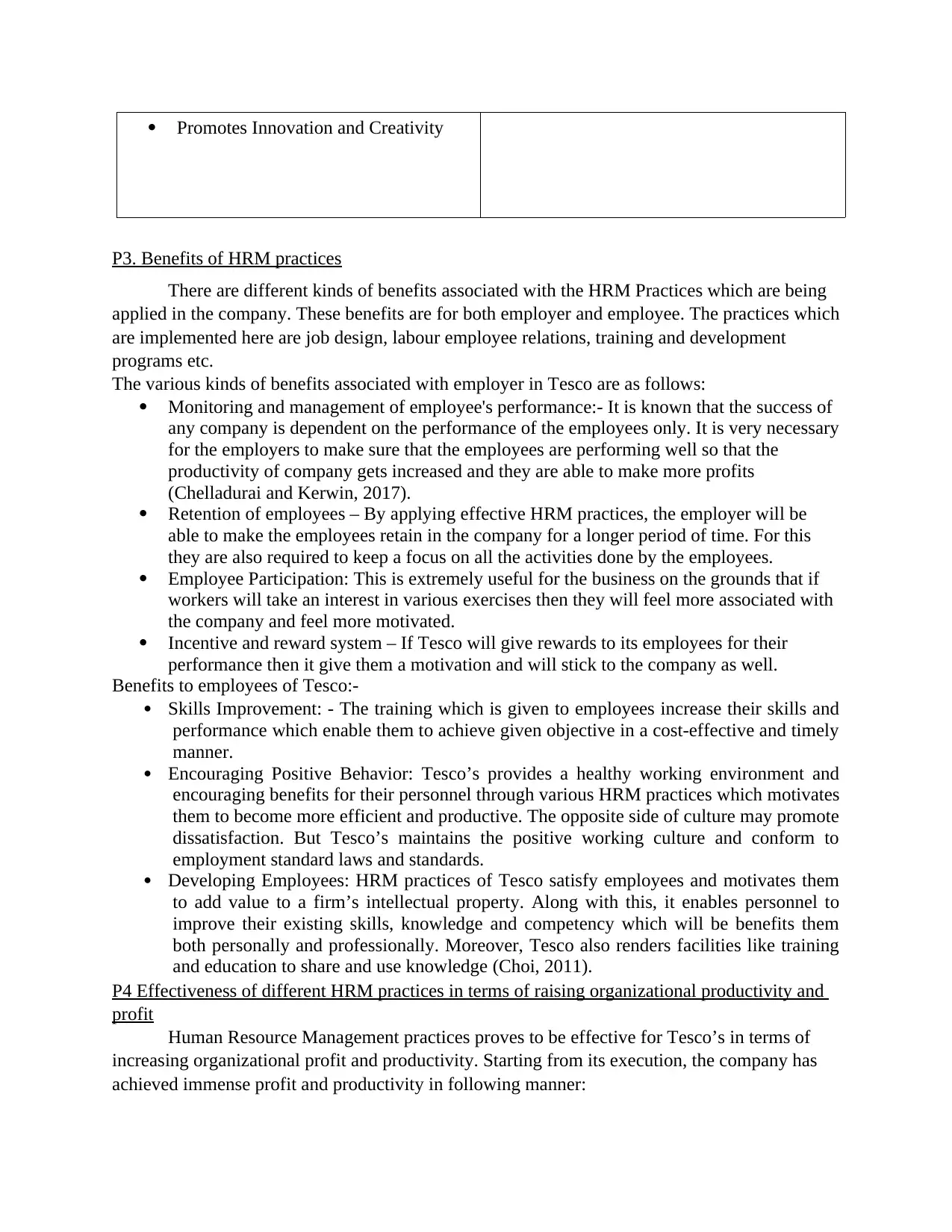
Promotes Innovation and Creativity
P3. Benefits of HRM practices
There are different kinds of benefits associated with the HRM Practices which are being
applied in the company. These benefits are for both employer and employee. The practices which
are implemented here are job design, labour employee relations, training and development
programs etc.
The various kinds of benefits associated with employer in Tesco are as follows:
Monitoring and management of employee's performance:- It is known that the success of
any company is dependent on the performance of the employees only. It is very necessary
for the employers to make sure that the employees are performing well so that the
productivity of company gets increased and they are able to make more profits
(Chelladurai and Kerwin, 2017).
Retention of employees – By applying effective HRM practices, the employer will be
able to make the employees retain in the company for a longer period of time. For this
they are also required to keep a focus on all the activities done by the employees.
Employee Participation: This is extremely useful for the business on the grounds that if
workers will take an interest in various exercises then they will feel more associated with
the company and feel more motivated.
Incentive and reward system – If Tesco will give rewards to its employees for their
performance then it give them a motivation and will stick to the company as well.
Benefits to employees of Tesco:-
Skills Improvement: - The training which is given to employees increase their skills and
performance which enable them to achieve given objective in a cost-effective and timely
manner.
Encouraging Positive Behavior: Tesco’s provides a healthy working environment and
encouraging benefits for their personnel through various HRM practices which motivates
them to become more efficient and productive. The opposite side of culture may promote
dissatisfaction. But Tesco’s maintains the positive working culture and conform to
employment standard laws and standards.
Developing Employees: HRM practices of Tesco satisfy employees and motivates them
to add value to a firm’s intellectual property. Along with this, it enables personnel to
improve their existing skills, knowledge and competency which will be benefits them
both personally and professionally. Moreover, Tesco also renders facilities like training
and education to share and use knowledge (Choi, 2011).
P4 Effectiveness of different HRM practices in terms of raising organizational productivity and
profit
Human Resource Management practices proves to be effective for Tesco’s in terms of
increasing organizational profit and productivity. Starting from its execution, the company has
achieved immense profit and productivity in following manner:
P3. Benefits of HRM practices
There are different kinds of benefits associated with the HRM Practices which are being
applied in the company. These benefits are for both employer and employee. The practices which
are implemented here are job design, labour employee relations, training and development
programs etc.
The various kinds of benefits associated with employer in Tesco are as follows:
Monitoring and management of employee's performance:- It is known that the success of
any company is dependent on the performance of the employees only. It is very necessary
for the employers to make sure that the employees are performing well so that the
productivity of company gets increased and they are able to make more profits
(Chelladurai and Kerwin, 2017).
Retention of employees – By applying effective HRM practices, the employer will be
able to make the employees retain in the company for a longer period of time. For this
they are also required to keep a focus on all the activities done by the employees.
Employee Participation: This is extremely useful for the business on the grounds that if
workers will take an interest in various exercises then they will feel more associated with
the company and feel more motivated.
Incentive and reward system – If Tesco will give rewards to its employees for their
performance then it give them a motivation and will stick to the company as well.
Benefits to employees of Tesco:-
Skills Improvement: - The training which is given to employees increase their skills and
performance which enable them to achieve given objective in a cost-effective and timely
manner.
Encouraging Positive Behavior: Tesco’s provides a healthy working environment and
encouraging benefits for their personnel through various HRM practices which motivates
them to become more efficient and productive. The opposite side of culture may promote
dissatisfaction. But Tesco’s maintains the positive working culture and conform to
employment standard laws and standards.
Developing Employees: HRM practices of Tesco satisfy employees and motivates them
to add value to a firm’s intellectual property. Along with this, it enables personnel to
improve their existing skills, knowledge and competency which will be benefits them
both personally and professionally. Moreover, Tesco also renders facilities like training
and education to share and use knowledge (Choi, 2011).
P4 Effectiveness of different HRM practices in terms of raising organizational productivity and
profit
Human Resource Management practices proves to be effective for Tesco’s in terms of
increasing organizational profit and productivity. Starting from its execution, the company has
achieved immense profit and productivity in following manner:
Paraphrase This Document
Need a fresh take? Get an instant paraphrase of this document with our AI Paraphraser

Innovating and High Performing Employees: The HR Department of any business enterprise
encourages innovative working environment and motivate worker by providing them better
facilities in terms to adequate training and development which leads to improve their overall
productivity that indirectly leads to increase organizational profit (Cummings and Worley,
2014).
Effective direction setting and execution: Managers and leaders play crucial role in setting the
purpose, goals, priorities, direction and roles of the employees. HRM assist Tesco in hiring
appropriate manager for the right place and at right time. With their effective contribution takes
the company to higher level in terms of generating more profits and revenues.
Team and Individual Goals with effective communication: With the help of HRM practices,
Tesco can set and accomplish both team and individual goal in an effective manner. Selecting
effective communication mode or channel aid in establishing good relation among employee and
management.
Effective reward drive performance: When monetary rewards are linked directly with the
performance of individual and also with each specific goal, workers tries to reinforce them and
start taking and completing task more seriously. This act as a motivational factor as it encourage
employee to put their best in the task assigned to them and tries to accomplish it cost-effective
and timely manner.
Non-monetary factors to improve employee performance: Like monetary factors, there are
various non-monetary factors that are available within the organization and leads to maximize
employee’s energy, excitement, loyalty and motivation. Such factors includes recognition,
praise, exposure, learning opportunities, challenges and feedback. It is the responsibility of
firm’s HR manager in terms of how effectively using these non-monetary factors so as to retain
employees for longer period.
TASK 2
P5 Significance of good employee relation
Employee relation is defining as a relationship between employer and employee. It is
very crucial in every organization that there should be a good relationship between management
and their staff members. It assists in maintaining healthy work surroundings as well as creates a
sense of belongingness among workers. They feel happy at workplace and work with
willingness. Healthy work surroundings and strong employee relation provides them a sense of
satisfaction and by this, are encouraged to perform in more effective manner. It improves the
productivity of workforce and at the same time, increase profitability of company. The manager
of Tesco ensures that good relationship among employees keep maintain at workplace. It is the
key of growth and success of firm (Daley, 2012). If the relationship is good, workforce will be
efficient, more productive, more loyal and creates less conflicts. There are various benefits of
good employee relation. Some of these are as follows:
It makes decision making process easy: There are many issues that takes place within an
organization on which it is difficult for an individual to take decision alone. If the relationship
encourages innovative working environment and motivate worker by providing them better
facilities in terms to adequate training and development which leads to improve their overall
productivity that indirectly leads to increase organizational profit (Cummings and Worley,
2014).
Effective direction setting and execution: Managers and leaders play crucial role in setting the
purpose, goals, priorities, direction and roles of the employees. HRM assist Tesco in hiring
appropriate manager for the right place and at right time. With their effective contribution takes
the company to higher level in terms of generating more profits and revenues.
Team and Individual Goals with effective communication: With the help of HRM practices,
Tesco can set and accomplish both team and individual goal in an effective manner. Selecting
effective communication mode or channel aid in establishing good relation among employee and
management.
Effective reward drive performance: When monetary rewards are linked directly with the
performance of individual and also with each specific goal, workers tries to reinforce them and
start taking and completing task more seriously. This act as a motivational factor as it encourage
employee to put their best in the task assigned to them and tries to accomplish it cost-effective
and timely manner.
Non-monetary factors to improve employee performance: Like monetary factors, there are
various non-monetary factors that are available within the organization and leads to maximize
employee’s energy, excitement, loyalty and motivation. Such factors includes recognition,
praise, exposure, learning opportunities, challenges and feedback. It is the responsibility of
firm’s HR manager in terms of how effectively using these non-monetary factors so as to retain
employees for longer period.
TASK 2
P5 Significance of good employee relation
Employee relation is defining as a relationship between employer and employee. It is
very crucial in every organization that there should be a good relationship between management
and their staff members. It assists in maintaining healthy work surroundings as well as creates a
sense of belongingness among workers. They feel happy at workplace and work with
willingness. Healthy work surroundings and strong employee relation provides them a sense of
satisfaction and by this, are encouraged to perform in more effective manner. It improves the
productivity of workforce and at the same time, increase profitability of company. The manager
of Tesco ensures that good relationship among employees keep maintain at workplace. It is the
key of growth and success of firm (Daley, 2012). If the relationship is good, workforce will be
efficient, more productive, more loyal and creates less conflicts. There are various benefits of
good employee relation. Some of these are as follows:
It makes decision making process easy: There are many issues that takes place within an
organization on which it is difficult for an individual to take decision alone. If the relationship

among management and staff members is good then they will help them in taking effective
decisions by providing them effective advice or suggestions.
Increase motivation of employees: If good employee relation is maintained, it will increase
motivation of employees. They feel confident and secure at workplace and perform their best.
This will also create a sense of trust between employer and employee (Guest, 2011).
Reduce conflicts: Healthy employee relation assists in reducing conflicts at workplace. It is the
responsibility of manager of Tesco to maintain good relation among them. it also helps them in
making effective decisions and keep maintaining a healthy workplace. If their relationship is
healthy, no misunderstandings between management and workers can takes place. So, it will
lower down the chances of reducing conflicts.
Team work: Good employment relation promotes team work. A firm becomes a happy
workplace if employees are working together as family. So, it is very important for administrator
of Tesco to maintain strong employee relation. This will promote coordination and cooperation
among them. it extracts out best of each employee.
Below mentioned are some strategies that helps manager of Tesco in improving employee
relation. These are:
They should ensure to involve their team members in process of decision making. It creates a
sense of belongingness among them and they are able to freely work within organization.
Encourage employees to share work with each other. This will increase interaction among them
and their comfort level will increase.
Promotes effective communication between team members as miscommunication creates lots of
misunderstandings and confusions among them.
Managers should conduct various activities within organization on regular basis. This will
increase participation of workers and provides them an opportunity of interact with each other.
Targets should be assigned to team members so that they can equally contribute in attaining
those within the given time frame.
P6 Key components of employment legislations & its influence on decision making
Employment legislation refers to the law that directs employment at workplace with all
those who works. It directly influences employer, workforce as well as trade unions. These laws
include some terms & conditions under which employees work, duties that worker and employer
owe & rules that are applied when a party wants employment relationship (Hobfoll, 2011).
There are various elements of employment legislations which influence decision making of
human resource manager of Tesco. Some of these legislations are defined below:
Anti-discrimination act: According to this act, discrimination is prohibited in employment on the
basis of caste, religion, age, sex, color, beliefs, marital status, disability, genetic information,
citizenship etc. It is the responsibility of every business organization to administer equal
decisions by providing them effective advice or suggestions.
Increase motivation of employees: If good employee relation is maintained, it will increase
motivation of employees. They feel confident and secure at workplace and perform their best.
This will also create a sense of trust between employer and employee (Guest, 2011).
Reduce conflicts: Healthy employee relation assists in reducing conflicts at workplace. It is the
responsibility of manager of Tesco to maintain good relation among them. it also helps them in
making effective decisions and keep maintaining a healthy workplace. If their relationship is
healthy, no misunderstandings between management and workers can takes place. So, it will
lower down the chances of reducing conflicts.
Team work: Good employment relation promotes team work. A firm becomes a happy
workplace if employees are working together as family. So, it is very important for administrator
of Tesco to maintain strong employee relation. This will promote coordination and cooperation
among them. it extracts out best of each employee.
Below mentioned are some strategies that helps manager of Tesco in improving employee
relation. These are:
They should ensure to involve their team members in process of decision making. It creates a
sense of belongingness among them and they are able to freely work within organization.
Encourage employees to share work with each other. This will increase interaction among them
and their comfort level will increase.
Promotes effective communication between team members as miscommunication creates lots of
misunderstandings and confusions among them.
Managers should conduct various activities within organization on regular basis. This will
increase participation of workers and provides them an opportunity of interact with each other.
Targets should be assigned to team members so that they can equally contribute in attaining
those within the given time frame.
P6 Key components of employment legislations & its influence on decision making
Employment legislation refers to the law that directs employment at workplace with all
those who works. It directly influences employer, workforce as well as trade unions. These laws
include some terms & conditions under which employees work, duties that worker and employer
owe & rules that are applied when a party wants employment relationship (Hobfoll, 2011).
There are various elements of employment legislations which influence decision making of
human resource manager of Tesco. Some of these legislations are defined below:
Anti-discrimination act: According to this act, discrimination is prohibited in employment on the
basis of caste, religion, age, sex, color, beliefs, marital status, disability, genetic information,
citizenship etc. It is the responsibility of every business organization to administer equal
⊘ This is a preview!⊘
Do you want full access?
Subscribe today to unlock all pages.

Trusted by 1+ million students worldwide

opportunities to all those individuals who are working within firm. They cannot discriminate
among them.
Data protection act: This act states that workforce is not liable to share any confidential data of
company with anyone. There are some situations in which an employee, for their personal
benefit leak information of firm. In this situation, an individual is solely responsible for its
consequences. So, as per this law, employees do not have any right to share confidential data of
business enterprise to any outsider person (Jiang and et. al., 2012).
Equality act: As per this law, it is necessary for employer to give equal and fair opportunity to
each employee without discrimination. It ultimately encourages some positive and healthy work
surroundings. This will provide a chance for growth and development to an individual. It also
promotes team working which results in increased productivity and performance.
Minimum wage act: This act defines that it is important for employer to provide minimum wage
to all the workers for work they have done. It provides a right to employee for getting minimum
wages for their work. This will help in increasing motivation level of manpower and if the get
appropriate amount of money, they feel satisfied and work happily.
Health & safety act: It is the basic right of an employee that they get a healthy and safe
workplace. This act states that it is the responsibility of an enterprise to provide health & safety
measures to their workers so that chances of happening accidents becomes less. They should
provide medical facilities to them. employers are required to render good work surroundings to
manpower.
Above mentioned are some legislations that depicts about the rights and responsibilities of
employer as well as workforce. All these legislations influence the decisions of human resource
manager. By the help of these legislations, managers can formulate effective policies related to
workers. These policies assist them in creating ethical work environment at workplace. These
policies will help in determining the responsibilities of employment. HR department is
accountable for compliance of laws related to employment & workplace. Human resource
administrator of Tesco is responsible to train other management personnel in order to ensure that
these legislations are being upheld all through the business organization (Lengnick-Hall, Beck
and Lengnick-Hall, 2011). The most common legislations that influence actions and decisions of
managers includes discrimination, equal employment opportunities, labour law etc.
P7 Application of HRM practices
A) Job Advertisement
JOB OPPORTUNITY
TESCO is searching for talented and skilled candidate for the available vacant job
position, in United Kingdom
JOB DETAILS:
among them.
Data protection act: This act states that workforce is not liable to share any confidential data of
company with anyone. There are some situations in which an employee, for their personal
benefit leak information of firm. In this situation, an individual is solely responsible for its
consequences. So, as per this law, employees do not have any right to share confidential data of
business enterprise to any outsider person (Jiang and et. al., 2012).
Equality act: As per this law, it is necessary for employer to give equal and fair opportunity to
each employee without discrimination. It ultimately encourages some positive and healthy work
surroundings. This will provide a chance for growth and development to an individual. It also
promotes team working which results in increased productivity and performance.
Minimum wage act: This act defines that it is important for employer to provide minimum wage
to all the workers for work they have done. It provides a right to employee for getting minimum
wages for their work. This will help in increasing motivation level of manpower and if the get
appropriate amount of money, they feel satisfied and work happily.
Health & safety act: It is the basic right of an employee that they get a healthy and safe
workplace. This act states that it is the responsibility of an enterprise to provide health & safety
measures to their workers so that chances of happening accidents becomes less. They should
provide medical facilities to them. employers are required to render good work surroundings to
manpower.
Above mentioned are some legislations that depicts about the rights and responsibilities of
employer as well as workforce. All these legislations influence the decisions of human resource
manager. By the help of these legislations, managers can formulate effective policies related to
workers. These policies assist them in creating ethical work environment at workplace. These
policies will help in determining the responsibilities of employment. HR department is
accountable for compliance of laws related to employment & workplace. Human resource
administrator of Tesco is responsible to train other management personnel in order to ensure that
these legislations are being upheld all through the business organization (Lengnick-Hall, Beck
and Lengnick-Hall, 2011). The most common legislations that influence actions and decisions of
managers includes discrimination, equal employment opportunities, labour law etc.
P7 Application of HRM practices
A) Job Advertisement
JOB OPPORTUNITY
TESCO is searching for talented and skilled candidate for the available vacant job
position, in United Kingdom
JOB DETAILS:
Paraphrase This Document
Need a fresh take? Get an instant paraphrase of this document with our AI Paraphraser
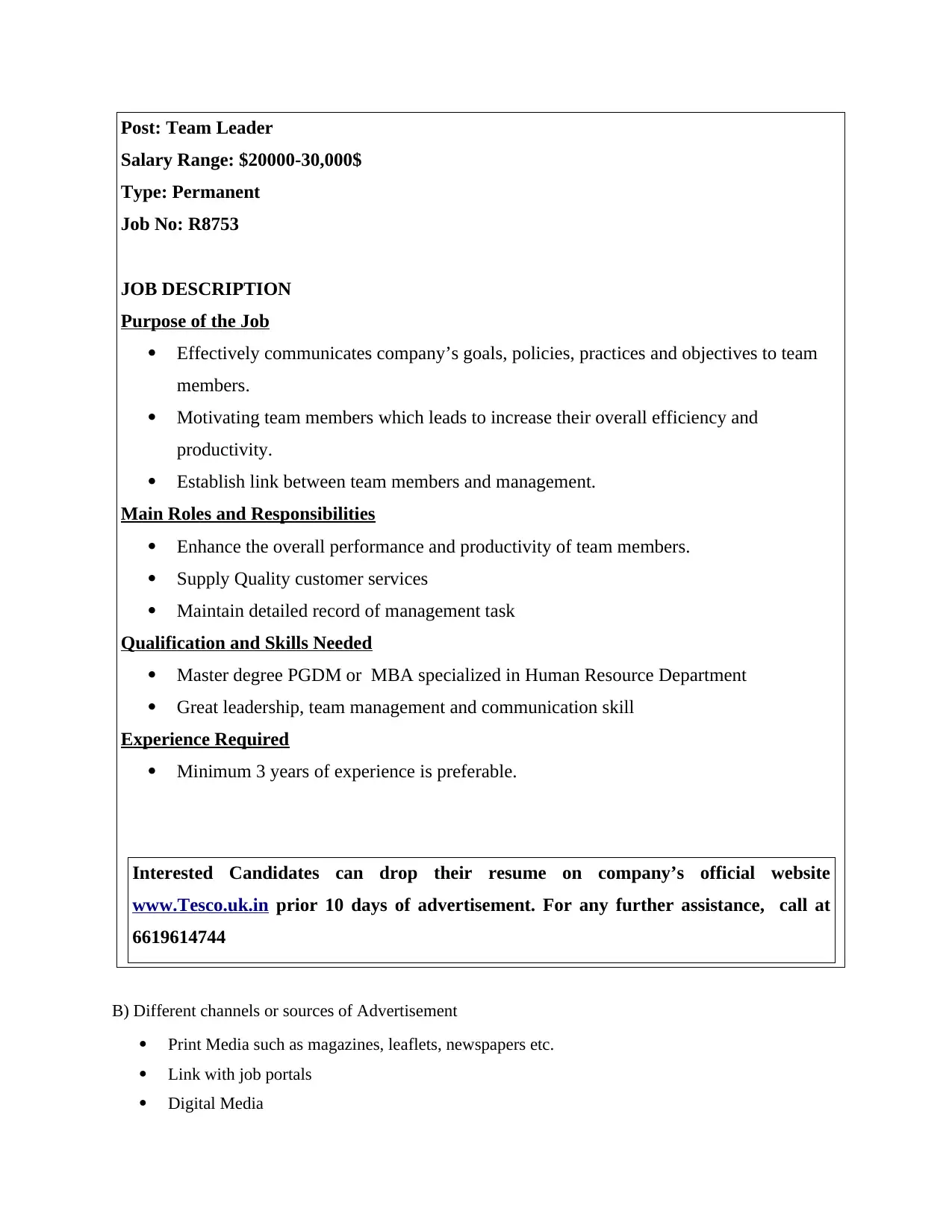
Post: Team Leader
Salary Range: $20000-30,000$
Type: Permanent
Job No: R8753
JOB DESCRIPTION
Purpose of the Job
Effectively communicates company’s goals, policies, practices and objectives to team
members.
Motivating team members which leads to increase their overall efficiency and
productivity.
Establish link between team members and management.
Main Roles and Responsibilities
Enhance the overall performance and productivity of team members.
Supply Quality customer services
Maintain detailed record of management task
Qualification and Skills Needed
Master degree PGDM or MBA specialized in Human Resource Department
Great leadership, team management and communication skill
Experience Required
Minimum 3 years of experience is preferable.
Interested Candidates can drop their resume on company’s official website
www.Tesco.uk.in prior 10 days of advertisement. For any further assistance, call at
6619614744
B) Different channels or sources of Advertisement
Print Media such as magazines, leaflets, newspapers etc.
Link with job portals
Digital Media
Salary Range: $20000-30,000$
Type: Permanent
Job No: R8753
JOB DESCRIPTION
Purpose of the Job
Effectively communicates company’s goals, policies, practices and objectives to team
members.
Motivating team members which leads to increase their overall efficiency and
productivity.
Establish link between team members and management.
Main Roles and Responsibilities
Enhance the overall performance and productivity of team members.
Supply Quality customer services
Maintain detailed record of management task
Qualification and Skills Needed
Master degree PGDM or MBA specialized in Human Resource Department
Great leadership, team management and communication skill
Experience Required
Minimum 3 years of experience is preferable.
Interested Candidates can drop their resume on company’s official website
www.Tesco.uk.in prior 10 days of advertisement. For any further assistance, call at
6619614744
B) Different channels or sources of Advertisement
Print Media such as magazines, leaflets, newspapers etc.
Link with job portals
Digital Media
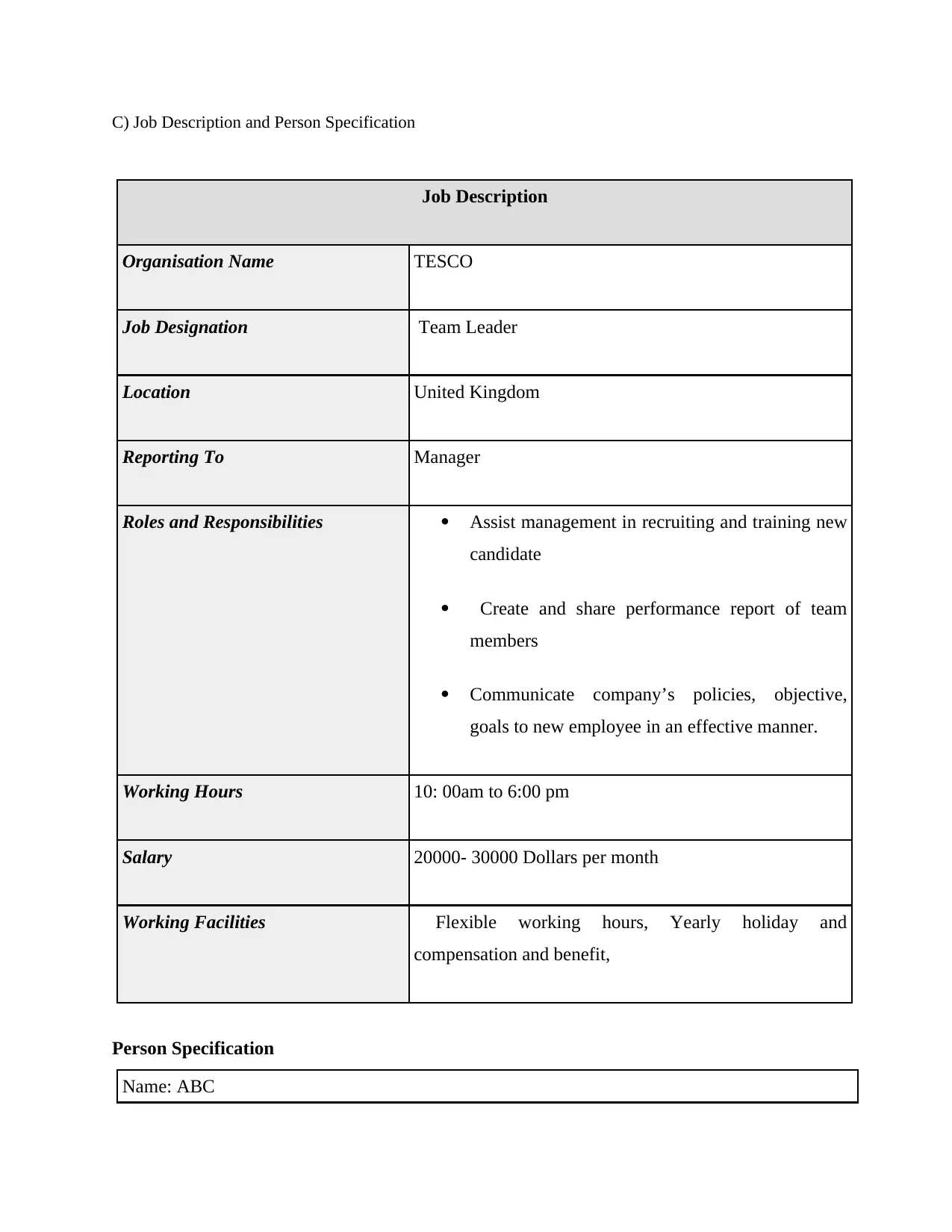
C) Job Description and Person Specification
Job Description
Organisation Name TESCO
Job Designation Team Leader
Location United Kingdom
Reporting To Manager
Roles and Responsibilities Assist management in recruiting and training new
candidate
Create and share performance report of team
members
Communicate company’s policies, objective,
goals to new employee in an effective manner.
Working Hours 10: 00am to 6:00 pm
Salary 20000- 30000 Dollars per month
Working Facilities Flexible working hours, Yearly holiday and
compensation and benefit,
Person Specification
Name: ABC
Job Description
Organisation Name TESCO
Job Designation Team Leader
Location United Kingdom
Reporting To Manager
Roles and Responsibilities Assist management in recruiting and training new
candidate
Create and share performance report of team
members
Communicate company’s policies, objective,
goals to new employee in an effective manner.
Working Hours 10: 00am to 6:00 pm
Salary 20000- 30000 Dollars per month
Working Facilities Flexible working hours, Yearly holiday and
compensation and benefit,
Person Specification
Name: ABC
⊘ This is a preview!⊘
Do you want full access?
Subscribe today to unlock all pages.

Trusted by 1+ million students worldwide
1 out of 16
Related Documents
Your All-in-One AI-Powered Toolkit for Academic Success.
+13062052269
info@desklib.com
Available 24*7 on WhatsApp / Email
![[object Object]](/_next/static/media/star-bottom.7253800d.svg)
Unlock your academic potential
Copyright © 2020–2025 A2Z Services. All Rights Reserved. Developed and managed by ZUCOL.





